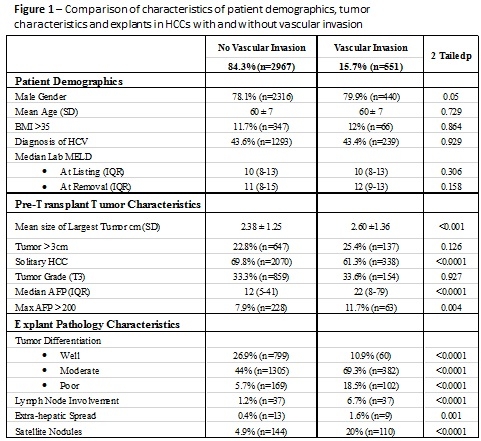The Influence of Rising Lab MELD on Vascular Invasion in HCC.
Liver Transplant & HPB Surgery, Weill Cornell Medical College, NY, NY.
Meeting: 2016 American Transplant Congress
Abstract number: 109
Keywords: Hepatocellular carcinoma
Session Information
Session Name: Concurrent Session: Hepatic Malignancies
Session Type: Concurrent Session
Date: Sunday, June 12, 2016
Session Time: 4:30pm-6:00pm
 Presentation Time: 5:30pm-5:42pm
Presentation Time: 5:30pm-5:42pm
Location: Room 304
Background Vascular invasion (VI) is one of the most important predictors of HCC recurrence. Although attempts to identify predictors of VI have been made, datasets have been too small to allow for accepted risk factors to be adopted. Here we present data from the largest HCC explant pathology database studied to date, and provide insight into the risk factors associated with VI.
Methods Analysis of UNOS database of HCC explant pathology specimens between April 2012 and September 2014. Recipient demographics, tumor characteristic and pathological data were recorded. Kaplan-Meier curves were used to compare survival between patients with and without VI. Multivariable logistic regression was used to identify independent predictors of VI.
Results 3,519 with evidence all of HCC on explant were included. Of these patients, 551 (16%), had VI. Patients with VI had significantly worse survival than patients without VI (2-year survival 76% vs. 84%, p<0.001). Figure 1 summarizes the results and compares patients with and without VI. Patients with VI had significantly larger tumors, were significantly more likely to be multiple and had significantly higher median AFP, and on explant, tumors were more likely poorly differentiated with satellite nodules and evidence of extra-hepatic spread (p<0.001 for all). The factors in Figure 1 as well as delta MELD (rise or fall in MELD >5 points) were included in the regression analysis. Four independent predictors of VI were identified: size >3cm (p=0.021, OR:1.30, CI:1.04-1.64), multiple tumors (p<0.001, OR:1.47,CI:1.20-1.80), AFP >200, (p=0.014, OR:1.48, CI:1.08-2.02) and a rise in MELD of > 5 points (p=0.004, OR:1.46, CI:1.13-1.88).
Conclusion In the largest series of HCC explants to be studied to date, we are the first to demonstrate a relationship between rising MELD and vascular invasion in HCC. This can possibly be due to greater inflammation associated with rising MELD scores or the inability to aggressively treat patient with loco regional therapy prior to transplant. This knowledge may aid in the selection of patients with out of criteria tumors who are considered transplant candidates. 
CITATION INFORMATION: Halazun K, Przybyszewski E, Verna E, Samstein B, Fox A, Brown R, Emond J. The Influence of Rising Lab MELD on Vascular Invasion in HCC. Am J Transplant. 2016;16 (suppl 3).
To cite this abstract in AMA style:
Halazun K, Przybyszewski E, Verna E, Samstein B, Fox A, Brown R, Emond J. The Influence of Rising Lab MELD on Vascular Invasion in HCC. [abstract]. Am J Transplant. 2016; 16 (suppl 3). https://atcmeetingabstracts.com/abstract/the-influence-of-rising-lab-meld-on-vascular-invasion-in-hcc/. Accessed December 25, 2025.« Back to 2016 American Transplant Congress
